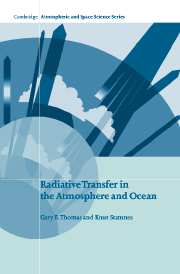Book contents
- Frontmatter
- Contents
- List of Illustrations
- Preface
- Acknowledgments
- Chapter 1 Basic Properties of Radiation, Atmospheres, and Oceans
- Chapter 2 Basic State Variables and the Radiative Transfer Equation
- Chapter 3 Basic Scattering Processes
- Chapter 4 Absorption by Solid, Aqueous, and Gaseous Media
- Chapter 5 Principles of Radiative Transfer
- Chapter 6 Formulation of Radiative Transfer Problems
- Chapter 7 Approximate Solutions of Prototype Problems
- Chapter 8 Accurate Numerical Solutions of Prototype Problems
- Chapter 9 Shortwave Radiative Transfer
- Chapter 10 Transmission in Spectrally Complex Media
- Chapter 11 Radiative Transfer in Nongray Media
- Chapter 12 The Role of Radiation in Climate
- Appendices
- Index
Chapter 11 - Radiative Transfer in Nongray Media
Published online by Cambridge University Press: 18 December 2009
- Frontmatter
- Contents
- List of Illustrations
- Preface
- Acknowledgments
- Chapter 1 Basic Properties of Radiation, Atmospheres, and Oceans
- Chapter 2 Basic State Variables and the Radiative Transfer Equation
- Chapter 3 Basic Scattering Processes
- Chapter 4 Absorption by Solid, Aqueous, and Gaseous Media
- Chapter 5 Principles of Radiative Transfer
- Chapter 6 Formulation of Radiative Transfer Problems
- Chapter 7 Approximate Solutions of Prototype Problems
- Chapter 8 Accurate Numerical Solutions of Prototype Problems
- Chapter 9 Shortwave Radiative Transfer
- Chapter 10 Transmission in Spectrally Complex Media
- Chapter 11 Radiative Transfer in Nongray Media
- Chapter 12 The Role of Radiation in Climate
- Appendices
- Index
Summary
Introduction
In comparison with shortwave radiative transfer, where nonlocal effects of multiple scattering are important, longwave radiative transfer is simple. This simplicity stems from the fact that the LTE source function (the Planck function) is determined strictly by the local temperature and is a smooth, analytic function of wavenumber. However, it is more complicated, because of the strong dependence of the absorption coefficient on wavenumber, and if that were not enough, a dependence on the pressure and temperature along the optical path. In this chapter we concentrate on the more practical aspects of computation of atmospheric fluxes and heating rates that are important for the energy flow. Infrared remote sensing is not considered, as other fine references are available. Generally speaking, IR radiative transfer in the ocean is not an important mode of energy transfer, except at the outermost “skin” (see Example 11.1), which acts like an opaque surface in transferring energy to and from the atmosphere.
We first consider the basic equations describing monochromatic transfer of radiation in a slab medium, consisting of purely absorbing (nonscattering) molecules. The necessary averaging of the flux equations over wavenumber and angle to yield quantities relevant to the energy flow pose significant computational problems. These problems are of a “mechanical” nature and have not yet been fully overcome, despite the current availability of superfast computers. Various schemes to solve this problem are discussed, including the brute-force line-by-line methods, narrow-band, and wide-band models.
- Type
- Chapter
- Information
- Radiative Transfer in the Atmosphere and Ocean , pp. 413 - 437Publisher: Cambridge University PressPrint publication year: 1999



